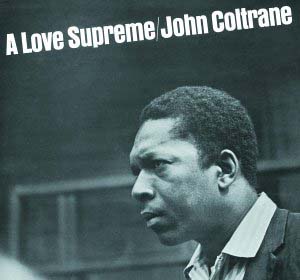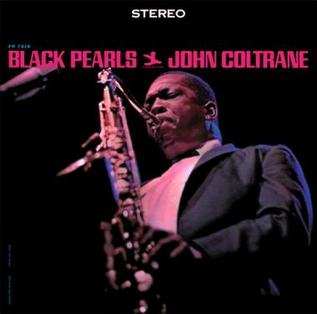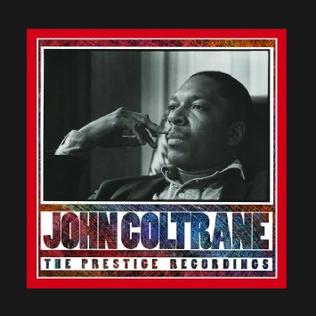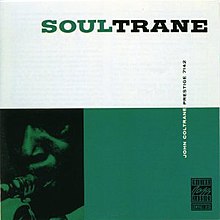
Tadley Ewing Peake Dameron was an American jazz composer, arranger, and pianist.
Sheets of sound was a term coined in 1958 by DownBeat magazine jazz critic Ira Gitler to describe the new, unique improvisational style of John Coltrane. Gitler first used the term on the liner notes for Soultrane (1958).

A Love Supreme is an album by the jazz saxophonist and composer John Coltrane. He recorded it in one session on December 9, 1964, at Van Gelder Studio in Englewood Cliffs, New Jersey, leading a quartet featuring pianist McCoy Tyner, bassist Jimmy Garrison and drummer Elvin Jones.

Rudolph Van Gelder was an American recording engineer who specialized in jazz. Over more than half a century, he recorded several thousand sessions, with musicians including Booker Ervin, John Coltrane, Miles Davis, Thelonious Monk, Sonny Rollins, Art Blakey, Lee Morgan, Joe Henderson, Freddie Hubbard, Wayne Shorter, Horace Silver, Herbie Hancock, Grant Green and George Benson. He worked with many different record companies, and recorded almost every session on Blue Note Records from 1953 to 1967.

Blue Train is a studio album by the jazz saxophonist and composer John Coltrane. It was released through Blue Note Records in January 1958. It is Coltrane's only session as leader for Blue Note. The recording took place at Rudy Van Gelder's studio on September 15, 1957.

Olé Coltrane is a studio album by the jazz musician and composer John Coltrane. It was released in November 1961 through Atlantic Records. The album was recorded at A&R Studios in New York, and was the last of Coltrane's Atlantic albums to be made under his own supervision.

Byrd in Hand is an album by American jazz trumpeter Donald Byrd recorded on May 31, 1959 and released on Blue Note later that year.

Coltrane is an album by the American jazz musician John Coltrane which was released in October 1957 by Prestige Records. The recordings took place at the studio of Rudy Van Gelder in Hackensack, New Jersey, and document Coltrane's first session as a leader. It has been reissued at times under the title of The First Trane!.

The Last Trane is an album credited to jazz musician John Coltrane, released in 1966 on Prestige Records, catalogue 7378.

Settin' the Pace is a studio album by the jazz musician and composer John Coltrane. It was released in December 1961 through Prestige Records. It is assembled from previously unissued tracks from a recording session at the studio of Rudy Van Gelder in Hackensack, New Jersey in 1958. Coltrane on tenor saxophone is accompanied by Red Garland on piano, Paul Chambers on bass, and Art Taylor on drums. With Garland and Chambers, Coltrane had played together since at least October 1955 in Miles Davis' band. With Art Taylor they were part of the Tenor Conclave recordings in September 1956. As a quartet they had already recorded two albums for Prestige, John Coltrane with the Red Garland Trio and Soultrane. The material the quartet recorded on this session were extended interpretations of three popular songs and "Little Melonae", a classic bebop tune written by Jackie McLean. Of note is Coltrane's use of the sheets of sound technique, particularly on "Little Melonae".

Black Pearls is a studio album by American jazz musician John Coltrane, released in 1964 on Prestige Records. It was recorded at a single recording session on May 23, 1958, at the studio of Rudy Van Gelder in Hackensack, New Jersey.

Mating Call is a studio album by jazz musician Tadd Dameron with saxophonist John Coltrane, issued in early 1957 on Prestige Records. It was recorded at the studio of Rudy Van Gelder in Hackensack, New Jersey.

The Prestige Recordings is a box set by jazz musician John Coltrane.

Coltrane "Live" at the Village Vanguard is a live album by the jazz musician and composer John Coltrane. It was released in February 1962 through Impulse Records. It is the first album to feature the members of the classic quartet of Coltrane with McCoy Tyner, Jimmy Garrison, and Elvin Jones, as well as the first Coltrane live album to be issued. In contrast to his previous album for Impulse!, this one generated much turmoil among both critics and audience alike with its challenging music.

Johnny Griffin, Vol. 2, also known as A Blowing Session, is an album by the jazz saxophonist Johnny Griffin. It was recorded in April 1957 and released in September or October the same year through Blue Note Records.

Coltrane for Lovers is a compilation album of recordings by American jazz saxophonist-composer John Coltrane, released posthumously on January 23, 2001, by Impulse! and Verve Records. The 11 tracks compiled for the album are all romantic ballads from Coltrane's early years with Impulse!, being recorded during December 1961 to April 1963 at engineer Rudy Van Gelder's recording studio in Englewood Cliffs, New Jersey. Dominated by Coltrane's classic quartet, the sessions also included collaborations with vocalist Johnny Hartman and pianist Duke Ellington.

Memorial is a 1956 jazz album by trumpeter Clifford Brown, issued posthumously. It was originally released on the Prestige label as PRLP 7055. It principally includes fast bop pieces, also arranged for a brass section. Ira Gitler, who was supervising session for Prestige label at the time, confessed he was greatly impressed by Brown: "When Brownie stood up and took his first solo on "Philly J J", I nearly fell off my seat in the control room. The power, range and brilliance together with the warmth and invention was something that I hadn't heard since Fats Navarro" Tracks 1-4 were recorded abroad with a Swedish All Star Group. Tracks 5-9 were recorded in New York as a Tadd Dameron led 10 inch LP minus the alternate take. Clifford and Benny Golson were the only horn soloists.

All Mornin' Long is a studio album by the jazz pianist and composer Red Garland. It was released in April 1958 through Prestige Records. It features only three pieces, which belong to the hard bop subgenre and distinguish themselves by being fast-paced and bluesy. Critic Ira Gitler found the album satisfactory and said that the title piece was a "many-splendored, deep-dish demonstration of feeling, mood and melody".

Forever Miles Davis is a three-disc compilation album by American jazz musician Miles Davis, released in 1981 by independent label Madacy Special Markets.

A Garland of Red is the debut album by pianist Red Garland, recorded in 1956 and released on the Prestige label.



















